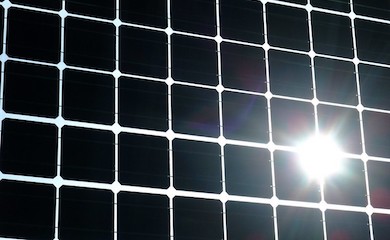Background
Commonly, for large scale solar PV plants, a vast amount of land is used. However, in places where there is scarcity of available land, solar PV developers have started building medium and large-scale plants on water surfaces. This is the case for Japan, which hosts 73 of the world’s 100 largest floating solar plants accounting for 246MW of solar capacity.

Yamakura Dam reservoir in Chiba Prefecture, Japan [1]
Why floating solar plants
Floating solar plants are a good solution where there is no available land. Despite some problems related to higher installation costs, higher mechanical stresses and corrosion [2], harnessing energy from floating solar farms can be efficient and profitable.
Floating solar plants can be installed and coupled with existing hydroelectric dams in order to maximise the space used to produce electricity. This arrangement can be effective when water levels reduce, can help to combat water evaporation from the reservoir, and it can lead to cost reduction since the existing grid connection is already in place. This combination is happening in China, where the world’s largest floating solar plant has been recently connected to the grid. The plant is expected to generate almost 78,000 megawatts in its first year, enough to power 21,000 homes. Thailand is also on its way to build 16 floating solar farms on 9 dam reservoirs.
Floating solar farms are also more efficient that onshore solar ones. An increase of 16% in efficiency is due the cooling effect of water upon panels reduce losses and extend the life of the plant. The greater efficiency offsets the higher cost of installation [2].
Conclusion
This promising technology grew by 100-fold between 2014 and 2018 and it might soon overtake the onshore solar PV in terms of energy produced. Potential drawbacks are: floating solar technology can have a negative impact on water ecosystem by blocking sunlight and they are vulnerable to extreme weather events. However, floating solar plants have great potential when installed on dam reservoirs and where power grids are weak, such as sub-Saharan Africa[3].
References
[1] Google Earth 2018
[2] World’s largest Floating Solar Testbed – Overview & Findings, Dr. Thomas Reindl, date: 18th June 2018, accessed: 3rd April 2019.
[3] How Japan became the world leader in floating solar power, Douglas Broom, date: 22nd March 2019, accessed: 3rd April 2019.
2 Comments
-
Hi Andrea, great read, would you be able to email me some further information on Floating Solar benefits, challenges and how to go about the design and development. We are building a new smart city and are seeking to build a dam to supply water and adopt floating solar as a way to minimise land-take and mitigate evaporation, whilst generating clean energy.
-
Hello Geoff,
Pager Power has no experience in building or developing floating solar farms, we offer several impact assessments for wind and solar farm and also tall buildings. However, I have some background on the topic and I can suggest a few interesting publications. In “Design and analysis of a combined floating photovoltaic system for electricity and hydrogen production” Mert Temiz and Nader Javani explore the potential of using floating photovoltaics for both electricity and hydrogen production. The study provides a system description, size, design, development and economics. It is fairly informative regarding variables to consider and I believe it might be helpful for you. I have found the paper at this link: https://www.sciencedirect.com/science/article/pii/S0360319919300230.
Another good paper is the “Integrating Floating Solar PV with Hydroelectric Power Plant: Analysis of Ghazi Barotha Reservoir in Pakistan” and it can be found at this link: https://www.sciencedirect.com/science/article/pii/S1876610219302243.
In “Floating photovoltaic plants: Performance analysis and design solutions” R. Cazzaniga assesses the performances of different floating solar farms designs. This paper might help you make a better design choice. I have found the paper at this link: https://www.sciencedirect.com/science/article/pii/S1364032117309103.
In conclusion there are many papers online that discuss design and development of solar farm which might help you. There are not so many about the challenges and the issues of floating solar farms since it is a relatively new technology. In regard to some benefits and challenges I have found Dr. Thomas Reindl’s lecture very informative “World’s largest Floating Solar Testbed – Overview & Findings”: https://d2oc0ihd6a5bt.cloudfront.net/wp-content/uploads/sites/837/2018/06/Thomas-Reindl-Worlds-Largest-Floating-Solar-Testbed-Overview-and-Findings.pdf.
-



